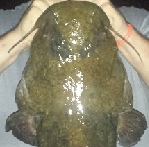|
That didn't work either, just tried it.
|
|
|
|

|
| # ? May 28, 2024 13:56 |
|
SynthOrange posted:
That fish is too big for that tank.
|
|
|
|
Sometimes my youtube stuff comes up with interesting things. Here is a fish room that currently has about 60 tanks in it. She got lucky in that the basement had an inlaw suite in it so she took over the kitchen/dinner room for the fish room: https://www.youtube.com/watch?v=PP-aTFlqtnk The other one is talking of dr tims fish food. Apparently you make your own gel food which you freeze. Kit comes with the food, baggy for the frozen cubes, and the cube tray. https://www.youtube.com/watch?v=iYRR-Sj_8dQ
|
|
|
|
JuffoWup posted:Sometimes my youtube stuff comes up with interesting things. That is pretty awesome but I feel like I can barely keep up with my 4 tanks.
|
|
|
|
I get that they probably sell them at least part time as well, but I feel the same way about that as the people who own like 60 bins of snakes. Sure they probably take care of them, but how do you get enjoyment out of a bunch of tanks that you can't even stand more than 3 feet away from because of how full the room is?
|
|
|
|
I do believe is a motoro stingray. We had a small female when I worked at the zoo. Named her Stripe because she was spotted. Little bitch figured out her feeding schedule and that I would sneak her treats. So any time I walked under her tank (she was on the top tier) she'd race up the back rock and spit several times. The only issue was the backup power strip that ran under her tank. Had to replace that more than once. I have a lot of tanks, and it does get tiring! But the Python is a godsend, and I don't have a fish room. Yet. An automated system would be fun too, but I have no idea or space on making one. Fish convention (the SAKE) went great. Came home with 2 pairs of red marble bristlenose (that have been hiding in their 20l QT tank). Mom got a betta and some assassin snails and the fish I donated made the club almost $100. Three bags of synos and one longfin blue-eyed bristlenose pleco, plus small angels and shrimp and some bichirs. Lots of cichlids this year, lots of plants and books, and even some axolotls.
|
|
|
|
I went out and got a betta. He's hiding a lot, but seems to be doing okay. As a side note, I had trouble searching for info on bettas on this forum due to there being a lot of people who post things like "Bernie keeps making legislation betta" and "Your rear end betta call somebody." Luckily I figured out how to search within Heavy Petting only, and that was more helpful.
|
|
|
|
Betta tips: Dont keep them in jars, dont get metallics/platinums, keep them like any other tropical fish. Enjoy your lil buddy.
|
|
|
|
Does anyone here keep Freshwater Eel-like fish? I currently have a 40 gallon - soon to be moved to a 100+ - with 4 eels, 4 barbs and a forever reproducing female guppy. The eels are, a tiny, 2.5 inch peacock eel, a 5 inch Tiretrack Eel, a 5" ocellated spiny eel (I'm aware they get enormous, hence the bigger tank), a Spiny Eel, and a mystery eel. Said mystery eel is about 5.5 inches, brown, a back that greatly resembles the spiny eel's (tiny spines running from it's dorsal to it's tail) and small dots from the back running almost all of the way up to the dorsal. I'm fairly sure this is a spiny peacock eel, however the dots do run run along the tail fin, they are actually on the eel's body, void of the tail completely. This could resemble a black spotted eel. Depending on the species, if it is a spotted eel, it will grow upwards of 20" With the current species in the tank, I have (hopefully) three eels that will remain quite small (6-12"). When the Tiretrack eel gets larger, what are the chances of it wanting to prey on the smaller eels? As for the guppy, my wife put it in there as a joke, it has birthed about 4 times with every fry disappearing forever into the gullet of eels.
|
|
|
|
Are outdoor ponds on-topic for this thread? I moved into my new house a month ago, and there is a fish pond in the back garden. The fish were left behind by the previous owners, who assured me that they are very low maintenance. I don't really know anything at all about taking care of them; I just go and throw some food in every so often (I am aware that their metabolism is dependent on temperature and that it is bad to have uneaten food floating around in there). I'm worried that one of them might have some sort of infection because there is a patch of white fluff visible on its side. I will try to get a picture later. It's not obviously in any sort of distress; its behaviour is the same as its companions from what I've observed. I'm also not sure if there is too much plant material in the pond.
|
|
|
|
I've been posting pond stuff in here, and a couple of people have posted some nice patio tub style ponds too. It's freshwater, so posting it here makes sense to me! Assuming you've got goldfish, if it's below 55F or so they probably shouldn't be eating at all since they won't have the metabolism to digest it until it warms up. White fluff could be a fungus patch, could be a nasty bacteria called columnaris, whatever it is you don't want it spreading to the other fish so keep an eye on it. Behaviour is usually a good indicator of fish health but sometimes a fish will be fine right up until the point it drops dead and goes rotten overnight (which is why you should attempt to do a fish count every day). A fish can usually fight off things with its own immune system as long as it has good conditions to live in, so if established fish are starting to show signs of illness, the conditions may have deteriorated to the point where the fish's immune system is too stressed. What kind of pond set up is it? How big (dimensions, volume)? Any filtration or circulation? How does the pond look, clear or murky water? How does the water smell? Are you able to do any water testing (Ammonia, Nitrite, Nitrate, pH, hardness)? Do you ever put extra/new water in, and if so where from? Do you treat this water in any way before it goes in the pond? Plants aren't a bad thing in a pond, unless there is no room at all for the fish to swim OR unless its dead and rotting. Ponds, like any artifical body of water containing fish, need to have a nitrogen cycle and oxygenation in order to continue to support fish life and plants can be a part of this. During the day plants provide oxygenation via photosynthesis. Different plants can use ammonia, nitrites and nitrates as fertilizer which makes the water cleaner and safer for the fish, and they provide surface area for denitrifying bacteria to colonise. As an example, my mum's pond has around 6 goldfish, a few water lillies, some random pondweed and a heap of algae. She had never done water changes or vacuumed sludge out of the bottom and was only topping it up with rainwater. She had no pump, no filtration and no circulation. I did some water testing and her ammonia, nitrites and nitrates were all undetectable, it was all handled by the plants! She was however getting pH swings from day to night due to the algae overgrowth affecting the oxygenation and CO2 levels in the water, which wasn't good. Since plants can't photosynthesise during the night, they switch to respiration and deoxygenate the water which is why circulation is a good idea. Fluctuating pH is stressful for fish, and once you start getting dead deoxygenated zones in the pond, anaerobic bacteria can get a foothold and start to make some really nasty stinky poisonous by-products. Bad for the fish, and really awful for whoever ends up having to clean it up. Anyway my final guess would be maybe there is a build up of organic materials (ie poop, dead plants or uneaten food), or maybe nitrates, which have pushed the water parameters outside of the ideal range for keeping goldfish and one goldfish has been unable to heal a small skin injury because of this. Maybe the goldfish have just gotten too cold and their metabolism and immune systems are too slow at the moment to fight off whatever this is. Goldfish are coldwater fish but it can get too cold for them, especially if the pond is not deep enough to stay warmer towards the bottom. I should have asked before, exactly how cold is it where you are? Trying to medicate a whole pond's worth of goldfish is probably going to be expensive depending on the size of the pond so unless you're keen to net the fish out and put it in a hospital tank it's probably fine to just keep an eye on it and see if it improves as the weather warms up. In the meantime if you're interested in giving these fish a healthy home, you could invest in a testing kit, check the water parameters, and if necessary scoop out muck, clear out dead plants/algae, provide circulation, work out a way to change out some of the pond water for fresh clean water until the parameters are back within a healthy range. Maybe just scooping some out using a clean bucket would do. That's clean as in never used for anything except fish things, not clean as in washed with soap. You don't need to make any big or rapid changes, that would probably be bad for the fish. Monitoring, making small adjustments, and having patience goes a long way. If your fungus fish is noticably getting worse I'd recommend separating it into a clean plastic tub containing some pond water so that you can medicate it without having to treat the entire pond. You could use a cheap hang-on-back filter to keep the smaller amount of water aerated (or an airpump and an airstone would work too I guess). But that situation has no filtration so you'd need to change the water every couple of days. Have a read about how to treat sick fish anyway so that if it comes to that, you will be better prepared on how to do it right. And if your fish dies, wrap it up and stick it in the bin, don't flush it down the toilet. Good luck!
|
|
|
|
Thank you for your detailed and informative post. I live in the UK (specifically, south Yorkshire). It's been mild the past couple of weeks, anywhere from 8 to 15 Celsius during the day I would say. They would eat a very little food if i threw it in even when it was a bit colder a few weeks ago. There is a pump, which I understand is significant in some way to the water quality. The pump is switched on 24 hours a day. It is working correctly as far as I am able to tell, but I am not very well-informed. The water is clear and does not smell. I don't add new water or take special steps to drain the water, though of course it must drain to somewhere when it rains. The previous owners didn't mention ever adding water or treating the water in any way. I would treat the water if it were called for and I could identify what treatment was required. I will look into pond testing kits. Here is a photo showing the whole pond. You can see most of the fish. The largest fish (grey, about twice as long as the second largest - I don't know what variety of fish any of them are) was lurking at the back and isn't visible.  Here are a couple of photos in which you can see the fish I am worried about :  
|
|
|
|
Hammerite posted:I live in the UK (specifically, south Yorkshire). It's been mild the past couple of weeks, anywhere from 8 to 15 Celsius during the day I would say. They would eat a very little food if i threw it in even when it was a bit colder a few weeks ago. Hammerite posted:There is a pump, which I understand is significant in some way to the water quality. The pump is switched on 24 hours a day. It is working correctly as far as I am able to tell, but I am not very well-informed. The water is clear and does not smell. Hammerite posted:Here are a couple of photos in which you can see the fish I am worried about :
|
|
|
|
That looks like a nice big pond, not overcrowded at all, and the waterfall where the water is pumped back in should have a nice aerating effect. Being completely set in the ground like that will help a bit against the chill but depending on how deep it is it might still be too cold. Does sound like it is still too cold to feed them yet. It does look like you've got some algae in there too unless the dark green blankety stuff is some other fine leafed pond plant. In my understanding it's harder to get rid of algae in colder climates as the usual remedies like barley straw or other microbial controls need enough warmth to be able to function so you might be stuck with manually pulling it out if it gets too overgrown. I'd be interested in whether there is any filtration associated with that waterfall or if it's purely for circulation. Where does the water go in to the pump? Either you have the pump in the pond and it pushes the water into the pond features, or you have the pump outside the pond and it sucks the water out. The latter configuration makes it easier to have a canister filter outside the pond. If the pump is in the pond it can get clogged easily and probably needs more maintenance than the other way around, but the other way of doing it you still need to make sure the inlet is clear and not dangerous for the fish and every few months it's probably still necessary to de-gunk the impeller. As for the white patch, it looks quite nasty and is bigger than I was expecting. I think you're right to worry about it. The thing with fungal infections in fish is they're often secondary to something else, either an injury or a lesion maybe from a tumour. In that fish, the circular shape of that patch made me think it might be due to an underlying tumour rather than rampant disease. Those guys look like regular goldfish to me, your big grey one that is off camera might be a koi or something else. Everything else looks pretty okay so I think at this stage it is likely just to be a problem with that one fish.
|
|
|
|
I had been assuming that if there wasn't any food left floating in the pond after a while, it meant that I wasn't overfeeding. As you both advise it's probably too cold for them to eat much, I will cut back on the amount of food I throw in.Stoca Zola posted:That looks like a nice big pond, not overcrowded at all, and the waterfall where the water is pumped back in should have a nice aerating effect. Being completely set in the ground like that will help a bit against the chill but depending on how deep it is it might still be too cold. Does sound like it is still too cold to feed them yet. It does look like you've got some algae in there too unless the dark green blankety stuff is some other fine leafed pond plant. In my understanding it's harder to get rid of algae in colder climates as the usual remedies like barley straw or other microbial controls need enough warmth to be able to function so you might be stuck with manually pulling it out if it gets too overgrown. Well, if it's a tumour then at least it's not something that will affect the other fish. There is pump stuff to the side of the pond, I should have mentioned it. You can see it here:   If you wanted to see the bigger one, it was more active today so here you go:  
|
|
|
|
Yup the filter is part of that pump assembly. You should be able to open the larger compartment and see the filter media. It's a good idea to rinse out the sponge periodically. Also that hard black tube inline with the pump hoses is probably a UV clarifier, and the bulbs on those need to be replaced every year or two. They're used to control algae growth. BTW those fish are most likely koi. How big would you estimate their size to be?
|
|
|
|
It dawned on me that a plastic-sleeved trombone cleaning snake makes for a fantastic way to clean out the lines on your canister filter. My lines are translucent and they were looking pretty skunky but now they look mostly clean again! And the flow looks a bit better, so there's that. Just don't pull the snake out with it pointed at your face. Really. Don't.
|
|
|
|
|
So, today I had a fish disaster: My dumb, ancient bristlenose decided to go for freedom when I was pulling out a bit of driftwood, hit the floor, thrashed around, nearly spiked me and generally did a lot of damage to himself. Is there anything I can do to help his survival chances?
|
|
|
|
Maybe put him back in the water...
|
|
|
|
Seriously though, as long as he's got clean water, a nice place to hide, and is otherwise pretty healthy he should heal himself up. Fish can grow back fins from almost nothing, and heal other wounds as well eg here's an example of a pretty serious injury that I've probably pasted in here before of a very damaged fish that was able to recouperate with a bit of time and care. Warning, you might find the images in that link a bit distressing.
|
|
|
|
Shakenbaker posted:Just don't pull the snake out with it pointed at your face. Really. Don't. Hint: Don't do it with a trombone either. Or any other brass instrument you use a snake on.
|
|
|
|
CrazyLittle posted:Yup the filter is part of that pump assembly. You should be able to open the larger compartment and see the filter media. It's a good idea to rinse out the sponge periodically. Also that hard black tube inline with the pump hoses is probably a UV clarifier, and the bulbs on those need to be replaced every year or two. They're used to control algae growth. I would put the big one at about 35-40cm long and the others are all about 12-15cm.
|
|
|
|
Hammerite posted:I would put the big one at about 35-40cm long and the others are all about 12-15cm. Keep them healthy - that big guy's worth a ton of money
|
|
|
|
I thought that whole thing about koi being worth a lot of money turned out to be mostly a myth? Or a common misconception? And that size actually means very little for value, its more about the patterns and colors of the koi. That breeders never sell their beautiful koi until they're grown and valuable. The $20-$50 small koi are the fish the breeder deems unlikely to increase in price at all. They sell the undesirable koi to fish shops and keep all the actual valuable koi so they can reap the profits themselves when grown out. So essentially the only way you're likely to get your hands on a $1000 koi is if you pay $1000 for one from a breeder. Can someone weigh in on this? My dad had a koi pond that came with the house he bought and a few years later the pump died. All the big koi died, Including a few that looked similar to the big white one in that picture. Me and my brother tried to inform him that he was looking at $5k of dead fish floating in his pond. He told me that wasn't how it worked. Are big koi really worth that much? If so who the hell buys them? Let alone values them that much?
|
|
|
|
I LIKE COOKIE posted:Can someone weigh in on this? My dad had a koi pond that came with the house he bought and a few years later the pump died. All the big koi died, Including a few that looked similar to the big white one in that picture. Me and my brother tried to inform him that he was looking at $5k of dead fish floating in his pond. He told me that wasn't how it worked. Are big koi really worth that much? If so who the hell buys them? Let alone values them that much? No, you're right. There's specific qualities in the coloration and size and shape of the fish that factors into the value of the fish. However that white one looks to me like it's got shiny scales, and a foot-long koi if that type would probably cost you >$400-500 from a breeder on its own. As the fish gets bigger its value goes up very quickly. Of course, if you're keeping them purely for fun, the value's not really relevant. It's just food for thought. CrazyLittle fucked around with this message at 05:44 on Mar 24, 2016 |
|
|
JuffoWup posted:Hint: Don't do it with a trombone either. Or any other brass instrument you use a snake on. Pfft. I've dumped active ant colonies about of trombones. I'm talking queen, workers, eggs, the works. What came out of my filter was a whole other level.
|
|
|
|
|
I LIKE COOKIE posted:I thought that whole thing about koi being worth a lot of money turned out to be mostly a myth? Or a common misconception? And that size actually means very little for value, its more about the patterns and colors of the koi. That breeders never sell their beautiful koi until they're grown and valuable. The $20-$50 small koi are the fish the breeder deems unlikely to increase in price at all. They sell the undesirable koi to fish shops and keep all the actual valuable koi so they can reap the profits themselves when grown out. So essentially the only way you're likely to get your hands on a $1000 koi is if you pay $1000 for one from a breeder. I'd buy this. Your average rich idiot who decides to build a large pond and stock it with Koi isn't going to want a bunch of small fish, so obviously the breeder can hold them, enjoy them, and then charge exorbitant amounts because the guy signing the cheque wouldn't look at the number twice.
|
|
|
|
I'm not really sure why but, I suspect over feeding has caused my water parameters in my freshwater tank to go off. I have a betta and 3 remaining of 10 cherry shrimp. I feed the fish once a day but, the roommates I have might have been feeding the tank as well, they won't admit it when I ask. The tank probably about half planted and I'm trying to figure out how to fix the chemistry so I can keep the rest of my shrimp. However the betta seems to be fine he's active, regularly eats and plays with the little mirror toy in his tank. These are the parameters over the last 3 days using the API master test kit for freshwater: pH: 6.4, 6.4, 6.0. Ammonia (ppm): 1, 1, 1. Nitrite(ppm): 5, 5, 5. Nitrate(ppm): 20, 20, 10. I added 1mL of seachem prime after the second day and waited 30 hours before testing it again. I want to raise the pH to something compatible with cherry shrimp breeding, ~7.4-7.6 but, I'm not sure how to go about doing it. I could raise it all at once however anecdotes I've read say that will kill the shrimp and I don't know how that would affect my betta. I think the nitrate is okay because of the plants I have in the tank. However the nitrite and ammonia are worrying the prime seems to have done nothing about them.
|
|
|
|
Azuth0667 posted:I'm not really sure why but, I suspect over feeding has caused my water parameters in my freshwater tank to go off. I have a betta and 3 remaining of 10 cherry shrimp. I feed the fish once a day but, the roommates I have might have been feeding the tank as well, they won't admit it when I ask. The tank probably about half planted and I'm trying to figure out how to fix the chemistry so I can keep the rest of my shrimp. However the betta seems to be fine he's active, regularly eats and plays with the little mirror toy in his tank. Get another test kit, or better yet, take a water sample in to your LFS and have them test it for you, if able. Your kit will still read the ammonia even after prime, as prime just binds the stuff up into a non-toxic form, it doesn't remove it. That said, I'd at least do a 25% water change immediately; it can't hurt if the tests are reading wrong, and if they're actually correct, doing so will get some of that ammonia and nitrite out of the tank before it starts doing damage. Re: koi... price/value is largely determined by patterns and coloration, though given the same "value" of pattern/color, bigger fish are going to be worth more $$$, simply because it takes time to get them big. Large (20"+) show koi can easily go for $1k+.
|
|
|
|
Azuth0667 posted:I want to raise the pH to something compatible with cherry shrimp breeding, ~7.4-7.6 but, I'm not sure how to go about doing it. Don't bother adjusting the pH, just keep it stable. Let it stay where it wants to be at naturally, easier and safer for the animals.
|
|
|
|
I've got 50+ baby shrimp in my little tank right now, and the pH is around 6.6-6.8. Stability does seem to be key (and keeping the ammonia/nitrates at 0).
|
|
|
|
If you're seeing any nitrites at all, your biological filtration isn't keeping up or has taken a hit from some chlorine or something. Better than seeing ammonia and no nitrites since at least some part of the cycle is still working. How old is this tank? What filter do you have? What plants do you have? How long did you let the tank cycle for? If you're hoping to use the plants to help soak up wastes you want something fast growing like hornwort or floating like frogbit or duckweed. You let it grow then you remove the excess. Definitely do water changes to get rid of nitrates too, 20 is about the absolute maximum you want it to get, not a level you want to keep it at. If you can measure it, there is more there than the plants are using. From experience I can tell you do not make rapid changes, it's a great way to shock and kill shrimp. Doing lots of smaller water changes is better than one big one. I forgot to say, 0.4 drop of pH in one day is a pretty big drop, what water are you using to do your changes? You might be heading towards a pH crash if you don't get a bit more buffering capacity into your change water. Don't use "proper pH" or any product that "sets" the pH at a particular level, they usually are not compatible with real plants. If your source water is too soft you can add a bit of buffering using something like seachem alkalinity, and seachem equilibrium has minerals for your plants. If you're worried about over feeding, take the food away and keep it somewhere that only you have access. Stoca Zola fucked around with this message at 06:27 on Mar 26, 2016 |
|
|
|
Stoca Zola posted:If you're seeing any nitrites at all, your biological filtration isn't keeping up or has taken a hit from some chlorine or something. Better than seeing ammonia and no nitrites since at least some part of the cycle is still working. How old is this tank? What filter do you have? What plants do you have? How long did you let the tank cycle for? If you're hoping to use the plants to help soak up wastes you want something fast growing like hornwort or floating like frogbit or duckweed. You let it grow then you remove the excess. Definitely do water changes to get rid of nitrates too, 20 is about the absolute maximum you want it to get, not a level you want to keep it at. If you can measure it, there is more there than the plants are using. I took a sample to the LFS and they tested it. They saw no nitrites or ammonia and the guy said api freshwater master kit can get false positives when using prime even after the reccomended 24 hr wait. The tank has been running for more than a month and I used a small amount of already cycled water from the betta's old 5 gallon bowl as bacterial seed. I cycled it for a month before running it. I'm using an aqueon filter good for up to 50 gallons, it doesnt have a model number on it but its the variety that hangs on the side of the tank. For plants I've got several patches of dwarf hairgrass that I keep having to separate and trim in addition to some larger slower growing plants in the back. I think one is cryptocryne willisii, micranthemum and rotala rotundifolia. I was using tap water for water changes and for that change but, this most recent one I switched to RO water since our tap has lots of phosphates and some copper compounds according to the local university. I've got aquarium salt from API I could use but, I am unsure if that will buffer. I was thinking of getting crushed coral as well for calcium for the shrimp and pH. E: the tank is heated too, to 78F. E2: the filter says aqueon 10. Azuth0667 fucked around with this message at 00:32 on Mar 27, 2016 |
|
|
|
Well you've gotta put something back in if you're using straight RO, it's too soft and almost nothing likes water that pure. There's no buffering at all and if you don't do something about it, your chances of a pH crash will rise. Good idea to avoid dodgy tap water though. Carbonate sand does work as a buffer but you don't really have any control over how much it's going to dissolve in your water. It's possible that the end result could push your pH too far in the other direction, but it should be more stable with sand than without . I've got some that I use in my guppy and barb tanks since they aren't fussy. The other thing is that plants and animals could do with different trace elements as well, but if you're feeding decent food and have a plant friendly substrate or are adding root tabs/other ferts that issue might already be covered. http://www.seachem.com/equilibrium.php is what I use with my RO water along with alkalinity buffer also by seachem. Rotala will grow faster if the nutrients/lighting are there, as a stem plant they count as being one of the faster growing plants so I think you've got a good mix of plants. Aquarium salt, if it's not marine salt, is unlikely to have any buffering capacity, it's more what you'd use to raise general hardness or treat ich without worrying about table salt additives poisoning your fish. It looks like the filter you have has little replaceable cartridges. I'm not really very fond of those since when you replace them you throw out all your good bacteria and have to start over, unless you have two sets of cartridges and you only replace one at a time. I think they add chemical filtration like activated charcoal and resins to make up for the dip in biological filtration that comes with a media change, but once those fill up they can't hold any more. I've got a couple of hang on filters, one has two little media baskets which are good because you can use whatever media you like then rinse one at a time without worrying about losing everything. The other one didn't come with any media so I have got layers of sponge and some seachem matrix stuffed in the chamber, which periodically gets rinsed and reused. If you have room in your filter media chamber maybe you could add some thin sponge and leave it in there, just rinsing it in your change water every now and then so that it keeps more continuous biological filtration when you change out the other bits? Anyway I think your main issue to target should be working out how to add some buffering back to your water, once you get that under control and a stable pH you can work out if over feeding is happening or not.
|
|
|
|
Forgot to say you could possibly get your coral sand in a sock made out of a clean/new/rinsed piece of stocking, if you can find one fine enough to not let the sand spill out everywhere. Then stick that in your filter so the water has to flow past it. It'll give your filter bacteria more surface to colonise as well as helping the buffering.
|
|
|
|
My cat managed to kill my Betta. He was perched on the lid while we were asleep as he tends to do and knocked the lid into the tank on top of the poor thing. loving cat. Trying to decide if I want a new Betta or turn the tank into a shrimp tank. It's a little 5 gallon one. Thoughts?
|
|
|
|
Your call, that sized tank would support either option.
|
|
|
|
Stoca Zola posted:Well you've gotta put something back in if you're using straight RO, it's too soft and almost nothing likes water that pure. There's no buffering at all and if you don't do something about it, your chances of a pH crash will rise. Good idea to avoid dodgy tap water though. Carbonate sand does work as a buffer but you don't really have any control over how much it's going to dissolve in your water. It's possible that the end result could push your pH too far in the other direction, but it should be more stable with sand than without . I've got some that I use in my guppy and barb tanks since they aren't fussy. The other thing is that plants and animals could do with different trace elements as well, but if you're feeding decent food and have a plant friendly substrate or are adding root tabs/other ferts that issue might already be covered. http://www.seachem.com/equilibrium.php is what I use with my RO water along with alkalinity buffer also by seachem. Rotala will grow faster if the nutrients/lighting are there, as a stem plant they count as being one of the faster growing plants so I think you've got a good mix of plants. Aquarium salt, if it's not marine salt, is unlikely to have any buffering capacity, it's more what you'd use to raise general hardness or treat ich without worrying about table salt additives poisoning your fish. I stuck a cube of foam in the intake to the filter to protect the shrimplets that the remaining female is carrying now. I hope that will be a good home to some beneficial bacteria. Its a filter rated for 50 gallons being used in a 10 gallon so I think the flow will be fine. Over feeding was happening so I hid all the food which pisses the betta off since he's used to eating whenever he wants instead of a structured 1-2 times daily. I tested again now that I have a GH/KH test from API and got: pH - 6.0 Ammonia - 1.0ppm Nitrite - 5.0ppm Nitrate - 5.0ppm GH - 35.8ppm KH - 71.6ppm I haven't had Prime in the tank for 4 days so it shouldn't be the cause of any false positives. I just got some seachem stability, equilibrium, and alkaline buffer so I'm going to follow the instructions on stability as if its a new tank since I can't get the nitrites or ammonia to reduce via water changes. I'm also going to treat with prime to hopefully render the nitrite harmless while the bacteria re-establishes. I want to increase the GH to ~90ppm and KH to ~143ppm to help with buffering and have ideal parameters for breeding. With a much higher KH it will be easier to prevent pH swings as well.
|
|
|
|
I would get new ammonia and nitrite test kits. It sounds like the ones you have are just bad, especially if your LFS tested the same water your kits tested at 1ppm and 5ppm and got 0/0. Personally, I've never used API tests, but they don't have the best reputation for accuracy. It's important to remember that test kits do expire as well...from what I've found, there should be a bottling date printed on the bottles somewhere, expiration is ~3 years beyond that date. Sadly, all of the really good test kits (i.e. LaMotte, Hach) are also really, really expensive.
|
|
|
|

|
| # ? May 28, 2024 13:56 |
|
I've been using API droplet/test tube kits since I started over a year ago (still on the same kit) and it's been okay so far. The nitrate and nitrite test always work and are easy to read, but the ammonia test sometimes is hard to tell between green and yellow ie the difference between zero and not much ammonia. I have trouble with seeing green sometimes though. I've never used dip sticks, I had the idea that as long as you're not dipping sticks you're going to get reasonable results. I guess you can try testing known clean water and known dirty water although not sure what'd be a good ammonia source? If you're detecting stuff from clean RO water definitely time to throw that test kit out (or maybe your RO system needs maintenance?). It is conceivable that this tank hadn't finished cycling or was overloaded with uneaten food resulting in a mini cycle which is where the nitrites etc came from. I wouldn't assume a bad test kit outright, especially if livestock are dying off. It's a bit hard to tell with shrimp though, some times they don't travel well. The bigger filter is good if it has more filtration media in it, but you don't want your flow rate to be too high! It blasts too much CO2 out of the water and plants don't like it.
|
|
|







 Two foot long ray just chilling.
Two foot long ray just chilling.
























